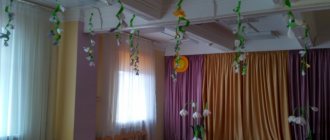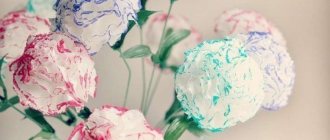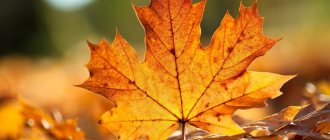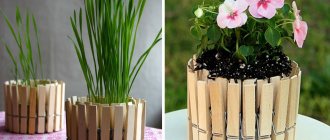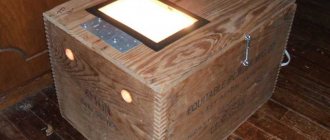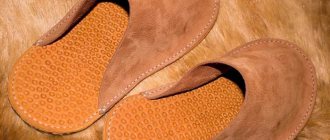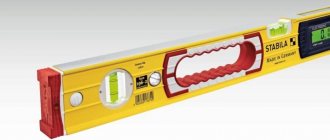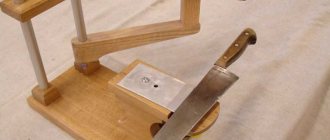It is not always necessary to strive for detail and clarity in a drawing or painting. Due to the abundance of little things, the mood of the work and the response that it could generate in the viewer can be lost. It is worth learning to give up something in favor of the main thing. Let's try to gain this skill by painting a still life with a bouquet of flowers in gouache with careless strokes. The nature for our work looks like this:
The original photo is on the website: https://www.photosight.ru/photos/4057004/
We will need : cardboard or a sheet of A4 drawing paper, a set of gouache, a jar of water, a palette, a cloth for wiping brushes, various brushes. For this type of work, it is better to use hard brushes, such as bristles. I use flat bristles No. 10 and No. 4, as well as a couple of softer brushes for individual details, mine are synthetic flat No. 4 and round No. 3.
Since the work is “rough,” we will draw without a preliminary sketch. We start by applying the background with a large, hard brush (#10 bristles). We cover approximately 2/3 of the top part of the sheet using red (a color close to burgundy), brown and white, achieving as smooth transitions between different colors as possible.
Apply strokes horizontally, from left to right and back. The corners are darkened more, we add more brown there, there is a lit area closer to the right side of the sheet, we add more white there. The background should not be a uniform color. In the photo it seems almost black, but I don’t recommend using black too much in drawings.
It turns out something like this:
Now we apply the main color of the table with brown and white, you can mix brown with a small amount of red in some places. If you work with a semi-dry brush, then due to the hard bristles it will leave an uneven mark, imitating the surface of a table. Just apply strokes horizontally in one direction.
The main color of the fabric is close to pink. We use a mixture of white and red, and in some areas you can add a cooler pink by mixing white and kraplak.
Later we will work on the fabric in more detail, but at this stage it is good to indicate the darker and lighter areas.
Here it is better to apply strokes in the direction of the main folds of the fabric and use a semi-dry brush with a large amount of paint, adding just a little water.
Now we can arrange the main objects of our still life in the drawing. Using whitewash and a thin soft brush we outline the outlines of the decanter and tray with a glass and quince. If it’s really difficult, you can first draw the outlines of objects with a simple pencil.
Leaves and flower stems are visible inside a glass carafe filled with water. Let's designate them with large strokes, using green, ocher and violet paint.
Now you can start working on the flowers. Using short and wide strokes in different directions, using a No. 4 bristle brush, paint yellow flowers.
We put more paint on the brush, almost like a spatula, so that the strokes are raised. We paint lilac flowers with thin and long strokes, using purple paint mixed with white.
Let's not forget to add greenery between the flower buds; you can lighten the green paint a little by adding yellow to it.
We specify the shape and size of the tray, glass and fruit and apply their primary colors. I enlarged them a little. There is no need to worry if you made a mistake somewhere, gouache is a paint that easily covers previous layers, so you can always correct something if you don’t like it.
For the metal tray we use gray (white + black) with a small amount of blue. We designate areas of light and shadow by diluting the paint with the required amount of white. For quince we use yellow, diluted with white in light areas, and add a little green to the paint in dark areas.
Again, we do everything with large strokes, using a lot of paint and a hard, medium-sized brush.
The main objects and colors of our still life are applied. Now we will go through all the work again in a circle, clarifying and detailing. Always try to work on the drawing as a whole, gradually bringing it to the desired accuracy.
So, we begin to refine the folds of the fabric. To do this, we look for areas of shadows (you can look at the nature a little squinting) and work them with purple paint, varying the shades by adding white and speckled paint.
Watch the direction of the strokes, try to apply them in the direction of the folds.
And we refine the light areas of the fabric with pink and white, with a dry brush. You can go over the dark areas a little with a dry brush with almost no paint, so that only barely noticeable traces remain.
Let's move on to the decanter. Here I use a softer brush (synthetic flat no. 4). We indicate the water level in the carafe with a white line, somewhere thicker, somewhere thinner.
Please note that the line is not straight, it bends in an ellipse, repeating the shape and volume of the decanter. The water in the decanter is a little cloudy, so let's put a little white in it.
In this case, the brush should be almost dry and there should be little paint on it, so that the color of the background and leaves can be seen through the strokes. Let's add highlights to the decanter and its handle using white.
Let's specify the flowers. For yellow ones, use ocher and white with yellow paint. Mix paints in different proportions to create different shades. For lilac flowers we use white, purple and maybe also kraplak. Let's add more yellow centers where they are visible. We refine the greens by adding darker and lighter shades.
Now we do the same with the glass, tray and quince. We refine the colors, add shades and highlights to the glass. We paint the water in the glass with white and a small amount of blue. We add ocher and green to the quince colors, make the highlights brighter with white, paint the “butts” with green and brown. On the tray we indicate brighter shadows.
The finishing touches remain. Using a thin soft brush, paint the shadow of the tray on the table with a mixture of black and brown paint. Make the area behind the decanter darker. On the tray you can paint small reflections from the quince in yellow. We clarify the angles on the folds of the fabric. This is what my finished drawing looks like.
- What about yours?
Source: https://izotika.ru/naturmort-s-cvetami/
Master class “Decorative still life. Gouache"
The fundamental tool of any work of fine art is composition.
Composition is present in everything: in the descriptive arts, the artist’s creation of his work, that is, the transfer by an architect into a construction project, by a sculptor into a relief or statue, by a painter into a painting or drawing, by an ornamentist into a decorative product of those lines, shapes and images that are still vaguely drawn in his imagination, and the composition (compositio) of them, an organic whole, definitely expressing the content he intended... a master class on drawing for children still life
Material from the site “Training and methodological office”
Master class “Decorative still life. Gouache"
Fundamentals of visual literacy: Balance in composition.
Natalya Aleksandrovna Ermakova, Teacher, Municipal budgetary educational institution for additional education of children “Children’s Art School named after A. A. Bolshakov”, Velikiye Luki, Pskov region. Description: the work can be done with children from 7 years old. The material may be useful to teachers of general education institutions, additional and preschool education. Purpose: design of creative exhibitions and interior design. Goal: creating a decorative panel in accordance with the laws of composition. Objectives: - continue to introduce children to the world of fine art, introduce them to the concept of the basics of visual literacy; - expand children’s horizons based on the concept of composition, introduce them to the basics of construction and the law of balance in composition; - improve skills in working in the gouache technique; - practice working with different with brushes in accordance with the task, exercise the ability to work with the entire bristle of the brush and its tip; - cultivate interest in the basics of fine arts.
Hello, dear guests! The topic that we will consider today is fine art, or rather its foundations - the foundations of visual literacy. First, let's define what art is. Art is a creative reflection, the reproduction of reality in artistic images. There are many types of art - these are historically established forms of creative activity that have the ability to artistically realize the life content and experience of people. Art includes artistic expression in literature, sound in music, plastic and color materials in fine arts - clay, plasticine, gypsum, various paints and much more. Fine art is the art of capturing images, a section of plastic arts, a type of artistic creativity whose purpose is is the reproduction (sculpting, drawing) of the surrounding world.
We live in a world where there are a number of rules that must be followed: traffic rules, rules of behavior in public places, spelling rules and many, many others. Fine arts also have their own rules, this is a whole science and it is called the basis of visual literacy. Knowledge of the basics of artistic techniques allows artists to intelligently use space, materials and environmental conditions to achieve the desired effect. Composition techniques allow you to build space dynamically and harmoniously. Graphic techniques can add sharpness or softness to a composition. The correct use of colors gives the desired psychological (joy, sadness) perception of the environment. And knowledge of perspectives is necessary when performing any artistic tasks. All together gives the artist ample opportunities to use light professionally, in particular, in any of its manifestations and with any tasks.
The fundamental tool of any work of fine art is composition. Composition is present in everything: in the descriptive arts, the artist’s creation of his work, that is, the transfer by an architect into a construction project, by a sculptor into a relief or statue, by a painter into a painting or drawing, by an ornamentist into a decorative product of those lines, shapes and images that are still vaguely drawn in his imagination, and the composition (compositio) of them, an organic whole, definitely expressing the content he intended.
How to choose a good palette
There are different plastic molds for applying varnish samples. Some have a completely transparent structure, others are milky, and others are white.
To apply the sample, it is better to use milk palettes. Or natural, slightly yellowish in color. The applied sample on them will be closest in color to the painted nail.
Some palettes cannot withstand the action of solvents - acetone or alcohol. These are not worth purchasing. Good professional palettes are made from durable plastic and are easy to work with.
Master class on painting with gouache
Do you ever have those moments when you see a beautiful flower and you want to transfer it to canvas or paper? Never put such moments in a drawer, because the feeling that overwhelms you is inspiration. Inspiration, as we know, is fleeting and capricious, so as soon as it comes to you, take a pencil, paper and create.
Just recently I saw a photo on the Internet with sunflowers and decided to make a still life master class using gouache, which has 12 colors. This is the still life I painted:
For the sunflower we need:
- Whatman
- Bristle brush No. 10 (and round brush No. 3)
- Pencil
- Gouache paints in 12 or 16 colors (I prefer the Neva palette).
Master class on painting still life with gouache
Let's make a preliminary sketch with a pencil. Here you simply indicate the location of the still life objects and their sizes on the sheet. Also, for convenience, you should divide the sheet into 4 parts.
After the sketch has been applied to the sheet, we proceed to painting the background. Looking at the original, you can see that the left side is darker than the right. We also choose what colors will be needed for the background.
In this still life, brown, ocher and white will be used as the base, and green and purple will be used as additional colors.
The paint should be applied in spots, in large strokes, using a bristle brush, trying to rub and mix the colors with other colors, achieving smooth transitions.
Why did I paint over the flowers? Because in this way the paint would not lie tightly and would lose in the picturesqueness, and secondly, it looks more holistic. This is important because our drawing is not a Lego toy where the parts are attached to each other.
And, in the end, the petals will not fill the entire space; there will be empty space between them, and if you do not immediately paint over this background, in the future it will be at least difficult to fill the space between the flowers.
Let's move on to applying paint to the “table”. You should choose brushes that are convenient in size. I advise you to take flat bristles No. 3 or No. 8.
Since the top of the table is better illuminated, you should use ocher, brown and white. The side of the table is in the shade, so you should not use whitewash. If you want to emphasize the depth of the shadow, use black.
Let's move on to drapery. As you already noticed, the drapery is painted orange, but if you look closely, you can see red, purple and brown, and where nearby objects are reflected, green and yellow.
For the jug we use ocher, iron oxide colors and other colors that you see. Please note that the light falls on the left side of the jug, and it is necessary to highlight this part with light colors, you can even add white. And don’t forget about the handle, because there are reflections of light on it too.
Since we painted over the sketch of our flowers, it needs to be restored. To do this, with a slight movement of the brush, draw a circle where the middle of the flowers will be. It is better to make the centers of flowers oval; only those flowers that look at you will be round. Use green to mark the place where the stems and petals will be.
Draw leaves, sepals and stems in green. Just as we painted over our sketch of flowers with the background, let’s cover some of the petals with yellow. To add shadow, use blue paint.
And now the most interesting thing - we draw flowers. We draw each petal with one bold stroke, from the center to the edge. Don't try to draw every detail, you can draw it later. Also, we should not forget that not all petals look in our direction.
Let's move on to the light on the petals. Determine immediately how the light will fall. The centers of the flowers are convex, the light also falls on them, to show this, use brown paint, adding black in dark places or white for highlights. The same colors can be used for the shadows on the petals.
We complete the details on the bottom of the picture – apples and sunflowers. The work has come to an end, and with it the master class on painting with gouache.
Video for training and inspiration
Source: https://webdiana.ru/dom-i-semya/rukodelie/3102-guash-master-klass.html
Making a basic palette for a beginning manicurist
For masters who have been working in the nail industry for a long time, who have tried a lot of different materials, studied customer requests and learned to track recurring trends, it is not difficult to create an optimal palette of gel polishes. But what should beginners do? What to rely on when selecting basic materials? Let's look into the issue and create a basic palette using TM UNO as an example.
Base coat
When choosing a base coat, you should pay attention to two of its characteristics: consistency and properties.
Consistency is important primarily for the master. Bases can be liquid, medium-thick or thick. It is easier for beginning craftsmen to work with medium-thick ones, since they are better distributed over the plate than thick ones, but at the same time they do not require the same speed of work as liquid ones.
As for the properties, here we are talking about the hardness/softness/elasticity of the base. Solid bases hardly bend after polymerization and are suitable for strong or brittle natural nails. Elastic bases, as the name suggests, remain flexible after polymerization and are suitable for soft, weak nails. As a rule, hard bases are more liquid, and elastic bases are slightly thicker.
Based on the fact that clients with very different nail conditions will come to the master, it is better to be prepared and have bases with different properties on hand. Our choice:
Top coating
The main requirement for a good finish is resistance to damage and color retention. And, of course, ease of use. Just like bases, topcoats have different consistencies - from liquid to thick - and just like with bases, it is better for beginners to start with medium-thick topcoats.
Another important point is the presence of a sticky layer. Tops with a dispersion layer are more suitable for soft and flexible nails, as they are more elastic. However, they take more time, since after polymerization the sticky layer must be removed. Tops without a sticky layer wear well on strong and hard nails and are suitable for fixing various types of designs.
Effective tops do not have to be included in the main palette, but in general they significantly expand the toolkit. Matte, “velvet”, with shimmer - even the most ordinary monochromatic manicure can sparkle with new colors.
Our choice for beginners:
Colored gel polishes
The basic palette does not have to be very large. Even experienced craftsmen should remember that too much choice can rather prevent clients from making a decision. It’s better to limit yourself to a set of a couple of colors and gradually add trendy shades or colors frequently requested by clients.
Basics:
Black, white and gray colors are the foundation of any nail palette. They are used both independently and for drawings, jackets, etc. UNO thick gel polishes require 2 thin layers for flawless coverage.
Nude shades:
Natural shades reliably hold the leading position in popularity, as they always suit everyone. In addition, they are an excellent basis for various patterns and designs.
Red palette:
There are colors that stay in trend for a couple of seasons, and there are unshakable classics. The latter, without a doubt, includes shades of red and pink. It’s good to have both cold and warm versions of them in the basic palette.
Rainbow shades:
It’s good if the basic palette contains shades of primary colors: blue, green, yellow, purple, brown. Choose them based on the trends of the latest seasons or according to your taste!
Source
Factory of artistic paints "Nevskaya Palitra"
"Master Class" - time-tested professional art paints. Recommended for professional artists seeking authenticity and durability of their works.
The Master Class series is aimed at the most demanding customers - professional artists.
Professional products made on the basis of high-quality expensive pigments (including pigments of our own production: coloring earths, cadmium and cobalt pigments) and carefully selected binders ensure the greatest authenticity and durability of the finished artwork.
The Master Class series includes sets of oil, tempera and gouache paints, as well as a large palette of individual tubes and cans of various packaging.
Competitive advantages of the Master Class series:
- High-quality pigments of our own production, including coloring earths; cadmium and cobalt pigments
- Fine paints with high pigment concentration
- The main part of the palette is mono-pigment and light-fast paints
- Purity and depth of colors
- Uniqueness and originality of shades
Oil paints "Master Class"
Master Class oil paints contain high-quality pigments (including pigments of our own production: cadmium and cobalt pigments, coloring earths) and a binder. Paints that are prone to color changes are made from a special non-yellowing oil. The rest of the colors are based on specially processed linseed oil. Highly artistic oil paints “Master Class” are products for the most demanding artists.
- Oil paints are available in 46 ml tubes (99 colors), as well as in sets of 6 colors in 46 ml tubes, 8 and 12 colors in 18 ml tubes.
- Artistic oil paints "Master Class"
Extra-fine artists' oil color “Master-Class”
- 101
- 100
- Neapolitan yellow-fawn 223
- 222
- 209 PY37, PY42, PO20, PW4
- 207
- 203
- 200
- 201
- 202
- 228
- 304
- 333
- 353
- 354
- 312
- 302
- 303
- Madder lake red permanent 339
- Madder lake rose permanent 338
- 617
- Kraplak purple durable Madder lake purple permanent 340
- Manganese purple light 614
- Cobalt violet light 602
- Cobalt violet dark 603
- 341
- 613
- 528
- 527 PG7, PB15, PW6, PW4
- 512
- 503
- 505
- Cobalt blue spectral 502
- 501
- 521
- 500
- 518
- 516
- Chromium Cobalt greenish blue 709
- Chromium Cobalt bluish green 708
- 507
- 733
- 732 PG7, PY83, PW6, PW4
- 703
- 720 PG7, PB15, PG17, PG8, PY1
- English green light 737
- English green dark 738
- 704
- 706
- 705
- 716
- 727
- 701
- 736
- 702
- 739
- 700
- 715
- 740
- 206
- 218
- 242
- 205
- 241
- 247
- 245
- 246
- 248
- 309
- 311
- 358
- 359
- 360
- 619
- 356
- 300
- 301
- 601
- 427
- 816
- Purple-brown Sevan 428
- 405
- 406
- 414
- 204
- Mars orange transparent 308
- 402
- 403
- Mars brown dark transparent Transparent Mars brown deep 404
- 401
- Natural umber Leningradskaya 407
- 408
- 808
- 812
- 817
- 800
- 813
- 811
- 801
Stage 1. Manicure
Before applying gel polish, you need to get your nails in order. Treat the cuticles and give your nails a beautiful shape. At this stage we will need:
Today there are 3 main types of manicure:
Hardware and combined manicures are done using a special device. Before using it, it is better to undergo training, since if used incorrectly, you can damage the nail plate.
It is better to do a classic manicure at home.
What do we do at this stage?
Gouache paints “Master Class” NEVSKY PALETTE, set of 12 colors, 40 ml each
Gouache paints “Master Class” NEVSKY PALETTE, set of 12 colors, 40 ml each
Artistic gouache “Master Class” NEVSKY PALETTE for painting, graphics and decorative works has high hiding power, mixes and spreads well. Paints applied to the surface are easily washed out, after drying they become dense, matte, velvety, the lower layers are not visible through the upper ones. Any materials with a smooth, slightly rough surface are suitable for gouache painting, especially paper, cardboard, and canvas. – The Nevskaya Palitra Artistic Paints Factory has been producing the highest quality products for over 80 years: watercolors, oils, tempera, acrylic, gouache, materials for decorative and applied arts, intended for professional artists and creative enthusiasts. Art materials from Nevskaya Palitra are successfully used for restoration work carried out in the most famous architectural monuments, such as the Hermitage, Tretyakov Gallery, State Russian Museum, St. Basil's Cathedral and many others.
Application area
For drawing, painting, graphics, decorative works.
Product characteristics
— a set of gouache paints in 12 plastic jars of 40 ml, packaging: cardboard box — the paint set contains 12 colors: titanium or zinc white, light yellow, light or golden ocher, red kraplak or red ocher or English red, red, turquoise or azure iron, ultramarine, light or dark violet, bright green or emerald light, dark green, burnt umber, gas soot - a water-based composition of finely ground pigments with the addition of gum arabic - a binding adhesive component of plant origin - manufacturer: Nevskaya Palitra, Russia
Instructions for use and nuances
Bristle brushes are suitable for painting with undiluted gouache paints; if you want to thin the paint with water or apply a thinner layer, use soft kolinsky or synthetic brushes. For gouache painting, choose high-density paper with a rough surface, such as watercolor or cardboard.
Source: https://samokraska.ru/artpaints/guash/gouache-masterclass-2
How to quickly fill a chamomile palette
The most common shape for nail polish samples is chamomile. Beginners sometimes have difficulty applying gel to it. But there is an easy way to apply gel polish to a chamomile palette.
Due to the fact that this palette is round, you will have to apply the gel polish in parts. You can paint one “petal” at a time, then it will turn out neat, but it will take a long time. Therefore, we apply gel polish to four petals and send them to the lamp. If you paint more, the gel will flow down, and the coating will become transparent in the center and with streaks on the sides of the petals.
So, four petals each, paint the entire circle in one layer. Then the second layer is repeated, after which it is covered with top. Here's how to properly apply gel polish to your palette.
How to make a palette for acrylic paints, Tips from Walter O'Neill
This post contains valuable advice on how to preserve your acrylic paint palette so it will last for months!
Read and remember!
For those who really can't do anything, I will explain how I make my acrylic painting palette. By following these steps, you can create your own palette to store your acrylic paints for months instead of minutes. What kind of magic is this? Maybe witchcraft, you say? Hah, this is just one of the many useful things I learned in art school, and I thought I'd save some useful tips for you and just write a post like this.
Step 1. Stop! Time to make a palette! Get yourself a cute 11" x 15" ceramic palette like this one. These things are made of metal and have a good ceramic coating. I've dropped it an unknown number of times and it's still usable. Do you really need one exactly like this for this tutorial? The hell with it. Just take your rectangular container, with sides about an inch wide. A container for food, a baking dish, heck, even a lasagne dish will work well for this.
Step 2: Build the foundation. Line the bottom of the palette with a paper towel. I usually use 6 or so layers of paper and it works fine. Try to keep the surface completely flat, if you have a thickening of paper in the middle of the form, add a little paper around the edges so that the surface is even.
Step 3: Get it wet! Fill the palette with water until the paper is completely wet. Hold the paper and drain the excess water, we want the paper to be wet and not turn into a cup of soup. If the palette is too wet, it will be reflected later when your paints become limp, dissolving in excess water. Read on, it will only take a minute.
Step 4. All air bubbles must die! Place your hands in the center of the palette and, moving towards the edges, smooth the paper, trying to force out any air bubbles that may remain between the layers of paper. It may take a few strokes like this, but in the end you should be left with a nice base for your wet paper palette.
Step 5: My paper or yours? Try to buy a good tracing paper that fits the size of the palette you created. Unless you work primarily digitally (in which case you may not be reading this tutorial), you simply must have a good tracing paper in your arsenal at all times. It has many (yes, yes, I said many) uses. For my palette I use Clearprint Vellum. It's not cheap, but it's tight and reliable and worth the money.
Step 6. Tracing paper is not just for copying. Take a sheet of tracing paper and place it on top of the toilet paper blank. The tracing paper layer will be the surface of our palette. Please note that the tracing paper begins to become moist because... there is wet paper underneath. This is fine. Same as in step 4, smooth out the paper and remove any air bubbles underneath.
Step 7. Do you like it? This is our ready-made palette for acrylic paints. A backing of wet toilet paper will moisturize paints that are losing moisture since there is no air underneath. Really cool science? After a few days or so, you can add a little water to the toilet paper to keep the palette moist. Simply fold back the corner of the tracing paper and add the required amount of water.
Step 8. Now go ahead and draw some crazy stuff! I became obsessed with this palette when I realized that my colors were mixing before I started painting. Here is an example of a simple grayscale I made while painting a black and white painting from my gallery. I started with gray and started mixing in white (top), and black (bottom).
When I don't need paints, I simply cover the palette with a plastic lid and put it in the refrigerator. Since paints can stay fresh for months, there is no need for garlands of wet paper hanging all over the room and becoming mildewed.
I hope the lesson was useful!
Author of the lesson and original text of the lesson: Walter O'Neal Translation from English: Iced Wings
Note: thank you very much Galka Zastava for the correction to the translation 
Stage 2. Preparing the nail plate for coating
Next, you need to prepare the nail plate for coating with gel polish. This stage is very important, since it determines how well the adhesion of the natural nail and the artificial coating will occur. To carry out proper preparation, we will need the following materials:
The acid-free primer acts as double-sided tape and ensures strong adhesion of the natural nail to the artificial nail.
The acid primer lifts the keratin scales of the nail plate for better adhesion to the artificial material. Since the acid primer contains aggressive components, you must be careful not to get it on the skin and cause a burn. It is recommended to use it before extensions for girls with wet or oily nail texture.
What do we do at this stage?
How to quickly fill a chamomile palette
The most common shape for nail polish samples is chamomile. Beginners sometimes have difficulty applying gel to it. But there is an easy way to apply gel polish to a chamomile palette.
Due to the fact that this palette is round, you will have to apply the gel polish in parts. You can paint one “petal” at a time, then it will turn out neat, but it will take a long time. Therefore, we apply gel polish to four petals and send them to the lamp. If you paint more, the gel will flow down, and the coating will become transparent in the center and with streaks on the sides of the petals.
So, four petals each, paint the entire circle in one layer. Then the second layer is repeated, after which it is covered with top. Here's how to properly apply gel polish to your palette.
Why does an artist need a palette?
First of all, our heroine serves as an indispensable assistant in choosing the right color. Very rarely does an artist manage to achieve the desired range of colors on a canvas with one stroke. In most cases, this is preceded by a long and painful search. Here the palette is simply irreplaceable. It saves the author from constant corrections in the picture itself.
Secondly, not all paints, like watercolors and gouache, are packaged in convenient trays and jars. Oil and tempera, for example, are most often sold in tubes. Keeping them open costs you more.
They can dry out and deteriorate. Again, you can’t do without a good palette here. I squeezed the desired colors onto it and write with pleasure, and the tubes can be securely screwed on and hidden in a box.
Thirdly, having a professional palette is a rule of good form for any painter. Imagine a symphony orchestra conductor in shorts and a T-shirt with a ladle in his hands instead of a baton. Funny. The painter without a palette is very similar to him.
However, there are exceptions everywhere. And good form is becoming more and more vague and controversial. However, we are not having a philosophy lesson. We're talking about an important tool in a painter's kit. That this is so is unlikely to be denied by anyone, so let’s talk about how to acquire a reliable weapon.
How to choose a palette for drawing
The simplest palette is a regular piece of paper that you use for drawing. Don't rush to throw away unsuccessful work. The reverse side of such a sheet can be a wonderful place for mixing watercolor or gouache paints. Many people are so used to this palette that they don’t want to change anything in their habits. And it should be!
Special devices for paint batches are much more convenient and economical. The paper absorbs some of the paint and dries quickly. This is why plastic and metal counterparts are much more effective in this regard. Some people love ceramic and glass palettes. But these assistants are only for very neat artists, which is very rare among creative people.
We went through almost all known materials, but did not touch upon the oldest and most popular to this day. Of course you guessed that this is a tree. Wooden palettes still serve reliably for most painters. Let's look at the main qualities of such tools that you should pay attention to when choosing them:
- Breed. This refers to the type of wood from which the palette is made. Usually light but durable types of wood are taken: apple, pear, beech, birch.
- Form. Usually it is a rectangle or oval. For convenience, a hole is made in one of the corners for a finger to make it comfortable to hold.
- Surface. Must be well polished, without defects and corrosion.
- Primer. A wooden palette can be soaked in vegetable oil or treated with an adhesive solution. After this, it is dried well. To prevent warping, place it under a press while drying.
So, you’ve got a great friend with whom you’re ready to go through thick and thin, but you don’t yet know how to use her. There are no exact rules here. Over time, everyone develops their own style of using the palette. However, the majority of recognized masters noticed that generally accepted principles have never harmed anyone. Let's repeat them too:
- Don't use too many colors. Typically, 6-8 primary colors are enough to create a rich piece.
- It is best to place them on the surface in a spectral sequence at a distance from each other in order to mix with other colors in between.
- Be sure to wash the palette well after use. You can, of course, scrape off the dried paint residue after a week, but it’s better to wash it off while it’s still fresh. Having accustomed yourself to this, you will not have to often change the much-needed tool.
- Store the palette in a dry, dark place, away from heating devices.
Well, that’s all that aspiring painters need to know about our heroine. Feel free to mix colors on it, remember our advice and resolutely go towards your intended goal.
Source: https://izokurs.ru/blog/hudozhestvennaya-palitra/
How to choose a good palette
There are different plastic molds for applying varnish samples. Some have a completely transparent structure, others are milky, and others are white.
To apply the sample, it is better to use milk palettes. Or natural, slightly yellowish in color. The applied sample on them will be closest in color to the painted nail.
Some palettes cannot withstand the action of solvents - acetone or alcohol. These are not worth purchasing. Good professional palettes are made from durable plastic and are easy to work with.
